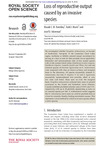Loss of reproductive output caused by an invasive species
| dc.contributor.author | Tremblay, Maude E.M. | en_US |
| dc.contributor.author | Morris, Todd J. | en_US |
| dc.contributor.author | Ackerman, Josef D. | en_US |
| dc.date.accessioned | 2016-07-04T03:48:54Z | |
| dc.date.available | 2016-07-04T03:48:54Z | |
| dc.date.issued | 2016 | en_US |
| dc.identifier.other | HPU4160327 | en_US |
| dc.identifier.uri | https://lib.hpu.edu.vn/handle/123456789/21838 | en_US |
| dc.description.abstract | We investigated whetherNeogobius melanostomus,aninvader of biodiversity ‘hot-spots’ in the Laurentian Great Lakes region, facilitates or inhibits unionid mussel recruitment by serving as a host or sink for their parasitic larvae (glochidia). Infestation and metamorphosis rates of four mussel species with at-risk (conservation) status (Epioblasma torulosa rangiana, Epioblasma triquetra, Lampsilis fasciolaandVillosa iris)and one common species (Actinonaias ligamentina)onN. melanostomus were compared with rates on known primary and marginal hosts in the laboratory. | en_US |
| dc.format.extent | 10 p. | en_US |
| dc.format.mimetype | application/pdf | en_US |
| dc.language.iso | en | en_US |
| dc.subject | Biology | en_US |
| dc.subject | Ecology | en_US |
| dc.subject | Unionidmussels | en_US |
| dc.subject | GreatLakes | en_US |
| dc.title | Loss of reproductive output caused by an invasive species | en_US |
| dc.type | Article | en_US |
| dc.size | 557KB | en_US |
| dc.department | Education | en_US |
Files in this item
This item appears in the following Collection(s)
-
Education [806]

